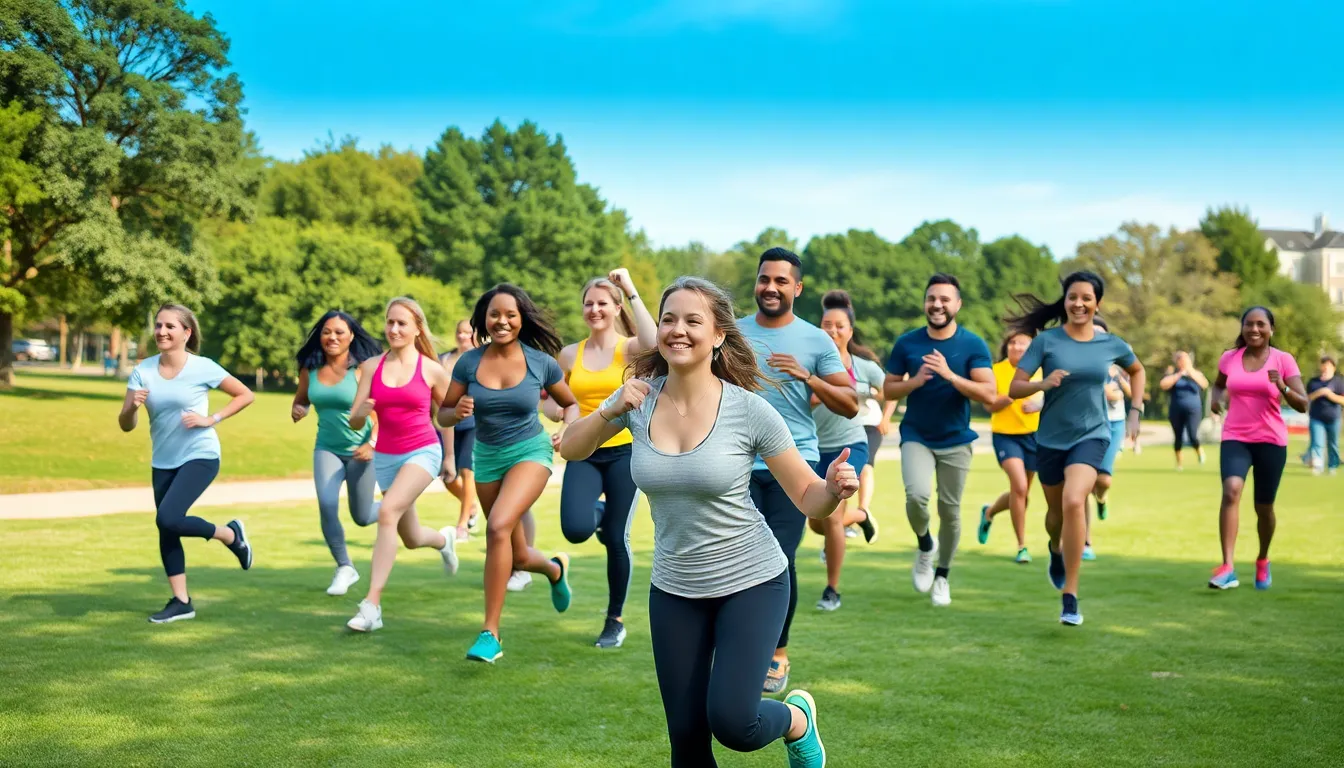Table of Contents
ToggleIn today’s fast-paced world, staying fit can feel like a daunting task. Many people struggle to find the motivation to maintain a consistent workout routine. That’s where fitness challenges come in, offering a fun and engaging way to boost physical activity and achieve health goals.
Fitness challenges not only promote accountability but also foster a sense of community. Whether it’s a month-long plank challenge or a daily step goal, these initiatives can transform fitness from a solitary endeavor into an exciting journey. Participants often discover newfound strength and resilience, pushing their limits in ways they never thought possible.
By embracing a fitness challenge, individuals can unlock their potential and cultivate healthier habits that last a lifetime. It’s time to take that first step and join the movement toward a fitter, more vibrant life.
What Is a Fitness Challenge?
A fitness challenge is a structured program designed to promote health and physical activity. These challenges often last from a few weeks to several months and encourage participants to meet specific fitness goals. Participants may engage in activities like running, cycling, strength training, or group classes, aimed at boosting overall fitness levels.
Fitness challenges typically include measurable objectives, such as increasing workout frequency or achieving a set number of steps. Engaging in these challenges fosters a sense of community, as individuals often support each other through social media or group events.
Many fitness challenges offer prizes or recognition, motivating individuals to remain committed. Organizations and gyms frequently host these challenges, making them accessible. The competitive element also pushes participants to reach their potential, enhancing both physical and mental well-being.
Benefits of Participating in a Fitness Challenge

Participating in a fitness challenge offers substantial benefits that enhance both physical and mental well-being. Engaging in structured programs can lead to significant improvements across various health aspects.
Physical Health Improvements
Increased stamina and strength are notable outcomes of participating in fitness challenges. Participants often experience enhanced cardiovascular health through consistent aerobic activities like running or cycling. Weight loss typically occurs as challenges encourage regular exercise and healthier eating habits. Improved muscle tone frequently results from strength training components within challenges. Enhanced flexibility may arise from diverse activities that include stretching routines. Regular involvement in these challenges promotes overall well-being and can lower the risk of chronic diseases.
| Health Improvement | Description |
|---|---|
| Increased Stamina | Enhanced ability to sustain physical activities. |
| Improved Cardiovascular Health | Enhanced heart and circulatory system function. |
| Weight Loss | Reduction in body weight through exercise and diet. |
| Improved Muscle Tone | Greater definition and strength in muscles. |
| Enhanced Flexibility | Increased range of motion and joint health. |
Mental Health Benefits
Boosted motivation and self-discipline occur as individuals commit to their fitness goals. Participants often report reduced stress levels and anxiety through regular physical activity. Improved mood frequently stems from the release of endorphins during exercise. Increased confidence and self-esteem develop as individuals achieve their fitness milestones. Additionally, social connections foster camaraderie, leading to stronger support networks. All these benefits contribute to enhanced overall mental health and resilience.
| Mental Health Benefit | Description |
|---|---|
| Boosted Motivation | Increased drive to achieve personal goals. |
| Reduced Stress | Lowered levels of stress hormones through exercise. |
| Improved Mood | Enhanced feelings of well-being and happiness. |
| Increased Confidence | Greater belief in personal abilities and achievements. |
| Stronger Social Connections | Established relationships that provide support and encouragement. |
Types of Fitness Challenges
Fitness challenges can be categorized into various types, each serving distinct purposes and appealing to different preferences. Understanding these categories helps participants choose the right challenge for their goals.
Individual Challenges
Individual challenges focus on personal goals, enabling participants to set and track their progress independently. These challenges often involve activities such as:
- Running: Participants may commit to a specific distance, like completing a certain number of miles within a month.
- Weight loss: Setting a target weight loss goal, usually measured in pounds over a defined period.
- Strength training: Individuals can aim for a specific number of sets or repetitions of exercises like squats or push-ups.
- Flexibility: Targets may include performing a series of yoga poses, progressing towards a particular pose, like becoming able to touch one’s toes.
Such challenges encourage accountability and self-discipline, fostering personal growth and resilience.
Group Challenges
Group challenges promote teamwork and social interaction, creating a supportive environment for participants. These challenges often involve activities like:
- Team sports: Groups can compete in structured leagues for sports like basketball or soccer, enhancing camaraderie.
- Relay races: Participants work together to complete laps or distances, encouraging communication and collaboration.
- Fitness classes: Groups join sessions such as boot camps or dance workouts, cultivating motivation through a shared experience.
- Online challenges: Participants can engage in virtual competitions involving workouts or meal planning, allowing for connectivity across distances.
These group dynamics not only enhance motivation but also strengthen community bonds, making fitness an enjoyable, shared endeavor.
How to Set Up Your Own Fitness Challenge
Setting up a personal fitness challenge involves clear planning and suitable activities. Establishing a structured approach enhances the likelihood of achieving fitness goals.
Defining Goals
Defining specific, measurable goals is crucial. Goals can include weight loss, muscle gain, or cardiovascular endurance. For instance, a participant might aim to lose 5 pounds or run a 5K in under 30 minutes. Utilizing the SMART criteria—specific, measurable, achievable, relevant, and time-bound—helps clarify objectives. Establishing short-term and long-term goals fosters motivation and accountability, keeping participants engaged.
Creating a Timeline
Creating a timeline sets a clear path forward. Timelines should span from a few weeks to several months, allowing adequate time to achieve the defined goals. For example, a 12-week framework promotes gradual progress and prevents burnout. Mapping out milestones within the timeline can also help participants track progress. Regular assessments during the timeline ensure the challenge remains effective and enjoyable, allowing adjustments as needed.
Choosing Activities
Choosing activities aligns with the defined goals and participant preferences. Activities can vary widely, including running, cycling, swimming, strength training, or yoga. Selecting activities that participants enjoy increases adherence and satisfaction. It’s beneficial to incorporate variety to prevent monotony and work different muscle groups. For example, mixing cardio with strength training sessions creates a balanced fitness regimen, optimizing overall results.
Embracing a fitness challenge can be a transformative experience. It not only enhances physical health but also nurtures mental well-being and social connections. By participating in these structured programs individuals can unlock their potential and foster a sense of community.
Whether opting for individual or group challenges the journey becomes more enjoyable and rewarding. Setting clear goals and tracking progress makes the process even more fulfilling.
Ultimately fitness challenges are a powerful way to cultivate lasting healthy habits and create a vibrant lifestyle. They offer an opportunity to push boundaries and discover newfound strengths while enjoying the journey toward better health.




